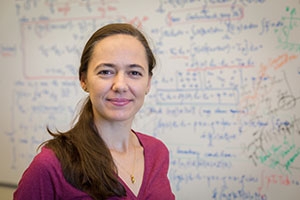 Applied mathematics Professor Noemi Petra develops algorithms and uses complicated computations to examine some of the world’s biggest problems — the ones that can’t be seen.
Applied mathematics Professor Noemi Petra develops algorithms and uses complicated computations to examine some of the world’s biggest problems — the ones that can’t be seen.
They are called inverse problems — using actual observations to infer the values of parts of the problem that can’t be directly observed, like calculating the density of the Earth from measurements of its gravity field.
For example, her most recent publication,“Scalable and Efficient Algorithms for the Propagation of Uncertainty from Data through Inference to Prediction for Large-scale Problems, with Application to Flow of the Antarctic Ice Sheet,” in the Journal of Computational Physics — written with collaborators at the University of Texas at Austin — shows a technique to infer information about ice flow deep below the Antarctic ice sheet and to quantify the uncertainties in this inference.
Researchers know it’s melting, they just aren’t sure what effects that will have on rising oceans, the climate or other consequences.
“Models usually contain parameters that are unknown, due to either the inability to directly observe them or their role as phenomenological parameters,” said Petra, who’s with the School of Natural Sciences. “One such parameter, for instance, is the basal sliding coefficient present in the equations modeling the base of the ice sheet. This parameter plays a critical role in understanding how the ice sheet moves, so we compute it indirectly by using available ice surface velocity observations.”
Her method uses a mesh overlay that covers the visible sides of the ice sheets on a map, and contains millions of tiny data points that log every aspect of the knowable topography. The super-high-resolution map that results demands a supercomputer to solve for more than 2 billion variables in the equations.
But with the right understanding of math and using available observations, researchers can solve for the missing ice-sheet parameters.
“Ice sheet models were left out of the Intergovernmental Panel on Climate Change’s fourth assessment report because of the many uncertainties in these models,” Petra said. “Our ultimate goal is to improve on modeling so climate scientists will be able to predict with much more certainty the ice-melt contribution to sea-level rise.”
The new paper is concerned with how to solve such large-scale inverse problems and quantify the uncertainties in the predictions of ice sheet models. Petra performed numerous computational tests to make sure the solution method works and it is efficient.
“You have to be able to know you can trust the models,” she said. “As far as I can tell, this is the first inversion resolution with such a detailed, full model, plus it accounts for the uncertainties.”
“Inverse problems are at the heart of many of our scientific and engineering challenges today,” School of Natural Sciences Dean Juan Meza said. “We are lucky to have had attracted one of the leading young scholars in this field to UC Merced.”
Petra’s work builds on a base of knowledge about modeling some of the world’s toughest questions to give people a better idea of what the future holds. Detailed information can lead to better planning.
While this paper helps the climate community, other problems she’s investigating include parameter estimation for large power grids. Her algorithms can be combined with other facets of modeling to help devise definitive models for most large-scale questions.
“I believe interdisciplinary and collaborative research is the answer to challenging computational science and engineering problems,” she said. “My goal is to bring to the table — and possibly extend — state-of-the-art mathematical tools to help solve important problems and answer questions for humanity.”